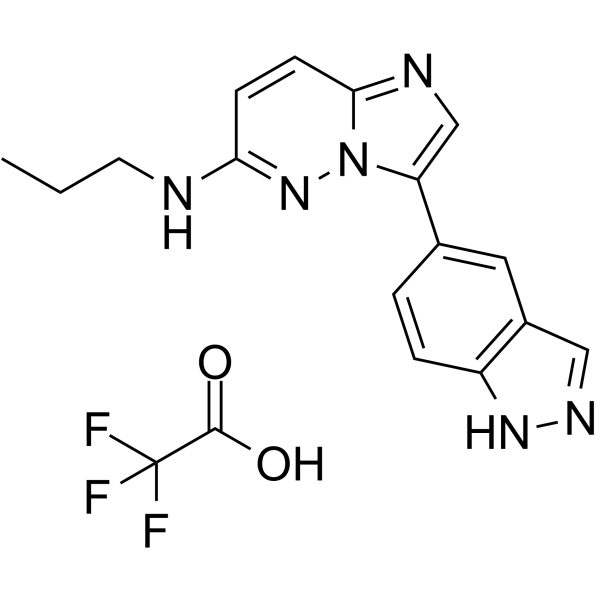1458630-17-5
| Name | 3-(1H-Indazol-5-yl)-N-propylimidazo[1,2-b]pyridazin-6-amine trifluoroacetate (1:1) |
|---|---|
| Synonyms |
MFCD24849399
Acetic acid, 2,2,2-trifluoro-, compd. with 3-(1H-indazol-5-yl)-N-propylimidazo[1,2-b]pyridazin-6-amine (1:1) 3-(1H-Indazol-5-yl)-N-propylimidazo[1,2-b]pyridazin-6-amine trifluoroacetate (1:1) |
| Description | CHR-6494 TFA is a potent inhibitor of haspin, with an IC50 of 2 nM. CHR-6494 TFA inhibits histone H3T3 phosphorylation. CHR-6494 TFA induces the apoptosis of cancer cells, including melanoma and breast cancer. CHR-6494 TFA can be used in the research of cancer[1][2][3]. |
|---|---|
| Related Catalog | |
| Target |
haspin:2 nM (IC50) |
| In Vitro | CHR-6494 (TFA; 0-105 nM; 72 hours) dose-dependently inhibits the growth of cancer cells, such as HCT-116, HeLa, MDA-MB-231, and Wi-38 cells, with IC50s of 500 nM, 473 nM, 752 nM and 1059 nM, respectively[1]. CHR-6494 (TFA; 500 nM) produces a mitotic catastrophe with abnormal morphology of the mitotic spindle and centrosome amplification, and upregulates the spindle assembly checkpoint protein BUB1 and the marker of mitotic arrest cyclin B1[1]. CHR-6494 (TFA; 0, 0.5, 1.0 μM; 24 to 36 h) is an inhibitor of angiogenesis in the ex vivo chicken embryo aortic arch ring assay[1]. CHR-6494 (TFA) exhibits inhibitory activities against melanoma cell lines, including BRAFV600E mutants, NRAS mutants, and wild type cells, with IC50s ranging from 396 nM to 1229 nM[2]. CHR-6494 (TFA; 300 nM and 600 nM; 72 hours) induces apoptosis, increases caspase 3/7 activity by 3- and 6-fold, respectively in COLO-792 cells, and to 8.5- and 16-fold in RPMI-7951 melanoma cells[2]. CHR-6494 (TFA; 50, 200 nM; 1 week) enhances the antiproliferative effects of MLN8237 in MDA-MB-231, SKBR3 breast cancer cells[3]. CHR-6494 (TFA; 200 nM; 72 hours) enhances the apoptosis of MDA-MB-231 and SKBR3 cells when combined with MLN8237[3]. |
| In Vivo | CHR-6494 (TFA; 50 mg/kg; i.p. in two cycles of five consecutive days for 15 days) inhibits the growth of tumor in nude mice bearing HCT-116 human colorectal cancer cells[1]. CHR-6494 (TFA; 20 mg/kg; intraperitoneal injection for 15 consecutive days) inhibits the tumor growth in nude mice bearing MDA-MB-231 xenograft tumors[3]. Animal Model: Male 4-5 weeks old athymic nu/nu mice harboring HCT-116 cells xenograft tumor with a tumor volume of 200 mm3[1] Dosage: 50 mg/kg (diluted in a solution of 10% DMSO/20% 2-hydroxypropyl-b-cyclodextrin) Administration: i.p. in two cycles of five consecutive days for 15 days Result: Dose-dependent tumor growth inhibition was demonstrated. Did not change the body weight of mice. Animal Model: 4‐week‐old female nude mice bearing MDA-MB-231 xenograft tumors Dosage: 20 mg/kg in a final formulation in 10% DMSO/20% 2‐hydroxypropyl‐β‐cyclodextrin Administration: i.p. for 15 consecutive days Result: Inhibited the tumor volume and weight compared with the control group in nude mice bearing MDA-MB-231 xenograft tumors. Enhanced the tumor volume and weight inhibition of MLN8237 (20 mg/kg; p.o.) in vivo. |
| References |
| Molecular Formula | C18H17F3N6O2 |
|---|---|
| Molecular Weight | 406.362 |
| Exact Mass | 406.136505 |
